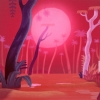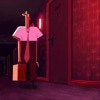In an industry fueled by the trends of the advertising world, it’s always nice when you stumble upon a body of work that stands out. Tom Rainford is an exceptional example of this.
Tom’s work has a voice, and it has integrity. His site is full of work that wasn’t just made for a deadline, for financial gain or even with a client in mind. He has a body of work that matters because much of it was made simply for the sake of making something beautiful. Which is why many of us get into this in the first place — and if we aren’t careful — it can be really easy to lose sight of that.
Tom has been a busy guy recently with updating his reel and website, and signing on with Studio AKA. I wanted to reach out to learn more about him and his mentality of making work that matters out in the English countryside.
First, who are you, how old are you and where are you at with your career?
I’m a 25 year-old who’s hopefully near the start and not end of an (eventually illustrious) career. I graduated a few years ago, worked full time in a studio for a year and have freelanced since.
You recently signed on with Studio AKA. How did that come about?
I’ve been aiming to work at Studio AKA for ages. One of the directors, Philip Hunt, got in contact a few years ago, and it’s been a dialogue heading in that direction for some time.
Do you feel a certain air of seriousness now that you are a director for one of the top production companies in the UK?
Definitely. As soon as I signed up, I immediately decided to start drinking coffee, and bought myself a pair of slightly thicker-rimmed glasses. It is sobering to be on the roster with such esteemed directors, but it’s what I’ve been aiming for.
I was first introduced to your work with the piece you did while at Art & Graft, “Factory.” I looked again today and that was made 3 years ago! That seems really ahead of the curve. How did that project come about and how do you feel looking back on it now?
I was an intern at Art & Graft in London during my final University year. As a side project, I was tasked with creating a new showreel intro that had to encapsulate the duality of the brand name.
At the time, I’d only been animating for less than a year, so the technical flaws are loud and clear. I think most animators are perfectionists, and it can sometimes be the most excruciating form of mental torture to revisit old work. On the other hand, people respond well to it, so it still clings onto the back of my showreels.
From an outsider’s perspective, the UK scene seems to have a very distinct voice and community. How do you feel being in the UK has shaped your work?
I think the distinct voice of UK animation is an unintentional by-product of the education system. There are countries that have really seminal colleges and universities for 2D animation, like Gobelins in France, that teach highly technical skills, with students forming teams to create grad projects.
As far as I’m aware, the UK doesn’t offer any courses that focus intensively on the same technical skills needed for 2D and traditional animation. I think this has led to a lot of isolated self-teaching for UK 2D animators, and, in turn, more idiosyncratic designs and techniques take form.
That’s certainly been the case for me – there’s not been any obvious educational path to follow. I’ve just ended up making stories and aesthetics that I enjoy instead of what’s considered traditionally ideal.
We are kind of in a renaissance of the handmade and traditional mediums. How do you feel this growing trend has affected you and your art?
I was brought up making artwork traditionally. I was one of those awkward ten year old kids that do watercolours of landscapes and charcoal drawings of statue busts. Hardly experimental stuff.
I’m really lucky that, by the time I left education, there was a market again for these traditional mediums in the context of animation. There has definitely been a huge injection of technology, and a diversification of content and style; it is now safer than ever before to be experimental.
I know you are working on a short film. If I am correct this is your third short! Where do you find the time and what would you say your ratio of time is on paying-the-bills jobs and passion jobs?
Right now, I would say 60% non-paid. I was lucky enough to get enough great paid jobs thrown my way to allow me to take some time aside to create a film.
But the film is going to be 10 minutes in length, and I’m the only one working on it. The production period is so long that I still have to be open to paid projects, even if I’m not actively seeking them out. After this film, I anticipate focusing solely on paid work for a long time.
What is “After Hours,” your upcoming short, about and is there anything you’d like to share about it?
The basic synopsis is as follows: “After Hours” is the story of a man who dies and goes to the afterlife, only to discover that it’s nothing more than a lousy motel in a barren strip of desert for the rest of eternity. Hilarity ensues.
It is primarily 2D, with some 3D and stop motion thrown in alongside my very own blood, sweat and tears. It’s very mixed-media.
Your work has a very distinct playfulness to it. How would you describe your voice and who/what inspires you?
What started in my student short “Grocery Day,” and what will continue through “After Hours,” is the creation of worlds that meld the fantastical and the crushingly mundane, to humorous ends.
Thematically, I’m inspired by irreverent, deadpan British comedy in the vein of Monty Python and Douglas Adams. Visually, I’m inspired by a huge range of stuff, from the work of other animators to old National Geographic illustrations. Inspiration can come from the most unexpected of sources, so I keep a pretty dense journal.
One thing that I always dig in others’ work is embracing imperfection. Whether it be an intentionally incorrect perspective, impossible scale or even just some mess-ups in color here and there, to me that’s what makes the handmade craft so beautiful, even if you are recreating it digitally.
How does this work its way into your work? Do you view it as a byproduct of the medium and just let it happen naturally or do you go out of your way to enhance the imperfections?
When it comes to making the backgrounds in “After Hours” and “Uloba,” I actually start by making a clean colour design before recreating it in messy watercolour. It feels like a destructive process, but it adds a spontaneity of form that I wouldn’t achieve if it was solely created on a computer, and it becomes much more exciting to me.
I wish I had the time to create the characters in the same way, but that would be crazy. I read that it took Wendy Tilby and Amanda Forbis seven years to make the fully painted Wild Life, and there’s two of them.
Something that stands out in your work is that it has a certain flatness that you’d expect with 2D work but you always seems to find a way to work a bit of depth into the scene, whether it be through an object’s volume or simply implied lighting. Can you elaborate on your process?
I like being able to believe that even stylised worlds can be stepped into and explored. I also enjoy dynamic camera movements, but then the illusion is quickly thwarted by the constraints of 2D. I try to use 3D and 2.5D when necessary to try to keep the illusion intact.
“Uloba” was an experiment in the transformation of flatness. The camera settles on a scene that looks distinctly 2D, and when the camera moves you see perspective changes indicative of 3D. It just sells the world that little bit more, even if it’s so subtle that it only works subconsciously.
Do you typically work in all 2D or are you bouncing between 2D and 3D a lot to achieve the desired look?
Over the past year, 3D has been increasingly a part of my process. I’m aiming to progress further. My next frontier will be 3D character animation. I don’t think I’ll ever turn my back on 2D though; I enjoy the aesthetic too much.
What is next for you? Do you have anything on the horizon you’re particularly looking forward to?
Getting my film out the door is my every waking thought. I’m looking forward to resuming a normal social and working life, and being able to move location to work more closely with Studio AKA.
Do you have any advice for those out there who would like to start working on more personal and fulfilling endeavors but find it difficult or scary to take on less of the paying-the-bills jobs?
I can’t really advise those who have been in the industry for longer than I have. To those who are up-and coming, or are new to animation:
It seems obvious, but in order to get good work you must first produce good work. If you wait for the right commercial job to come along that will prove every aspect of your creative talents, you might be waiting a long time. The only sure way to do this is to take matters into your own hands and give yourself your own perfect project. I certainly wouldn’t be working on a film if I didn’t think it would help my career afterwards.
Most importantly, make sure you’re financially covered before you commit! For a project as ambitious as a 10 minute film, it also helps to have honest and supportive people around for the moments you want to pack it in and move to Antarctica.
Thank you Tom!
If you missed the link above you can view Tom’s website HERE and if you’d like to work with Tom you can get in contact with his rep, Studio AKA HERE.














